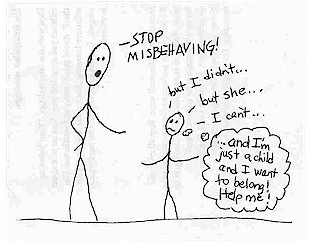| The Four Mistaken Goals of Misbehavior
ch 4 in Positive Discipline by J. Nelsen “A misbehaving child is a discouraged child.” -R. Dreikurs |
 |
| The Four Mistaken Goals of Misbehavior:
1. Attention-- “I belong only when I have your attention.” 2. Power -- “I belong only when I’m winning or in charge or at least when I don’t let you win.” 3. Revenge -- “It hurts that I don’t belong, but at least I can hurt back.” 4. Assumed Inadequacy -- “I give up. It is impossible to belong.” Remember: the true primary goal of all behavior in all people, children or adults, is to find a sense of belonging and significance (56). As teachers, we are given the opportunity to help children understand their behavior. Not only that--we are given the chance to help them shape their own behavior to achieve significance and belonging they desire! Also remember: “Children are good percievers, but poor interpreters” (21). It important that your communication is clear, so think things through before you speak. “An encouraged child does not need to misbehave” (62). About Goal Disclosure:
|
|
|
|
|